
WHERE ARE YOUR MANNERS
One thing I’ve noticed while studying email fundraising copy, is that there isn’t nearly enough thanking going on.
In direct response fundraising, the basic formula for fundraising is to Ask for a donation, to Thank the donor for giving, and then to Report back to donors how all that money was used towards meeting your organizations’ goals.
This is the basic fundraising cycle. It simply gets repeated over and over again.
Sure, sometimes you might do a special appeal for a specific project or emergency, or a matching gift appeal when the opportunity strikes, but you still follow the same basic formula.
But for some reason, fundraisers seem to think this formula only applies to direct response appeals.
And boy is that a mistake. The same guidelines hold true no matter what platform you are using for your fundraising.
In fact, because it’s much cheaper to send an email thank you letter than it is to mail an actual thank you letter with postage, you would think that nonprofits would be sending thank you emails all the time.
But they aren’t.
And when then do, they frequently aren’t timely, or donor centric, enough.
WHAT’S IN A LETTER
So what should be in an effective thank you letter?
1. First, it should be timely. Testing has shown that the best success is achieved by organizations that send a thank you letter within 48 hours of receiving a donation.
2. It needs to be personalized. Therefore, you need to make sure your ESP (email service provider) is capable of incorporating donors’ names without a struggle. And yes, it does matter. Donors love it when their names are specifically mentioned in a letter.
3. The word “YOU” needs to be used a lot. Not just once or twice. And others forms of the word you, like: your and you’re, count.
4. There is no such thing as too much flattery in a thank you letter. Phrases like “Your generosity saves lives…” are one example of how flattery can fill your donor with a sense of pride and self-satisfaction for giving.
5. And don’t forget to tell the donor how their donation solved a problem or changed lives:
For instance you might incorporate sentences like these into your letters:
- Because of you, we were able to bring live theatre back to the community.
- Because of your generosity, ten families have a roof over their heads.
- Because of you,100 dogs were pulled off death row.
Nothing packs as much of a punch as when you tell donors exactly how their money made a difference.
YEAH, YEAH, YEAH—WE ALREADY DO THIS
Right now, I’m sure a large majority of readers are thinking, we already know this. We already do these things.
Then why are so many of the thank you letters I receive for my donations so lacking.

- Some don’t arrive for a week or more.
- Others aren’t personalized.
- The word “you” is rarely used enough.
- Most talk all about the organization way too much.
- And some don’t send a letter at all—only a receipt.
I can’t tell you how many times I’ve donated to an organization in the last year and didn’t receive anything other than a receipt.
REALLY PEOPLE????
With automated email programs there is no excuse for this.
Luckily this isn’t true of every organization I support. Some of the organizations are doing a great job with their thank you letters.
THESE LETTERS MADE ME FEEL SO GOOD ABOUT MY DONATIONS
The following excerpt from the Soi Dog Foundation is a great example of an effective thank you letter.
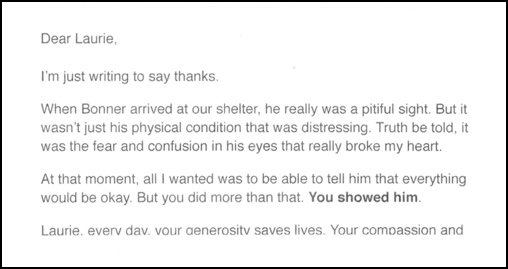
I have to admit when John Dalley, the Co-Founder of Soi Dog says “You showed him,” I got a bit choked up. Me! And I do this for a living. But no one is immune to flattery. Everyone likes to have their ego stroked—even if we don’t like to admit it.
Here is another excerpt from the same letter:
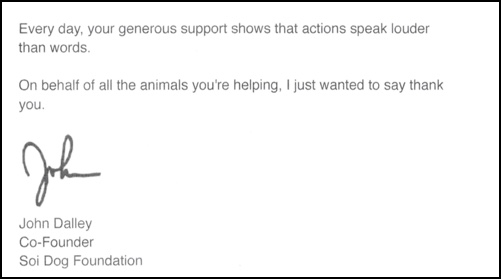
John Dalley uses the word you, or derivatives of it, 7 times in just these two excerpts.
Nicely done!
In this next example from Humane Society International, they jump right in with the donor centricity.
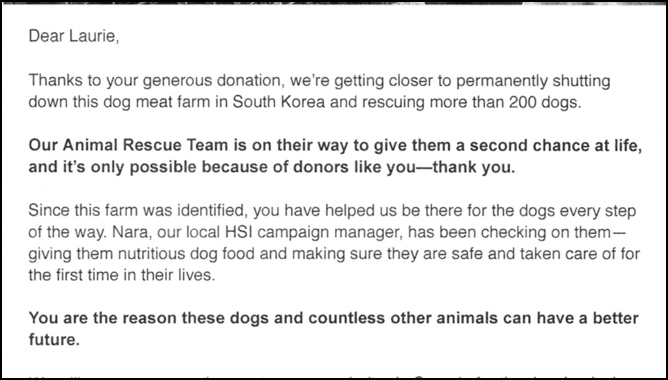
While it takes a little practice to make a letter donor centric, without making the letter feel awkward, it is doable as this letter shows.
This letter touched me from the first sentence. The writer is obviously aware of my desire to shut down dog meat farms, and specifically mentions how my donation is helping to close them once and for all.
Well done.

THESE LETTERS FELT LIKE THEY NEED SOME WORK
The following letter from SPCA International isn’t a bad letter. It just isn’t donor-focused enough.
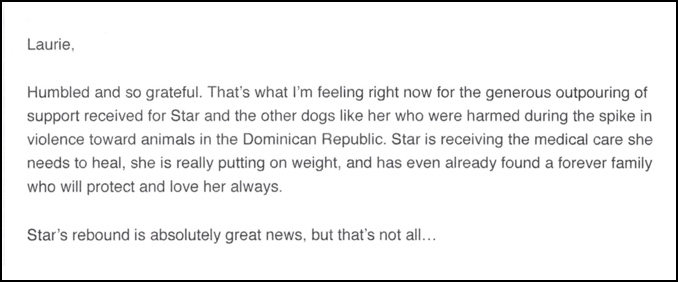
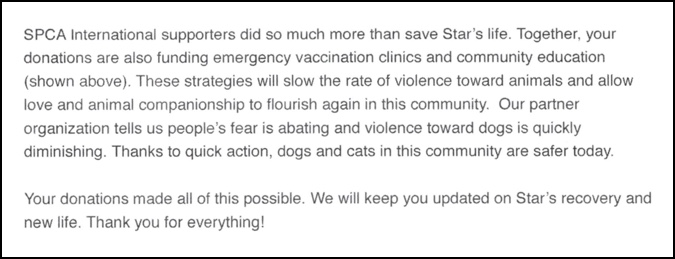
The writer uses the word “you” only two times. Yes, they use the word “your” twice, but once it refers to “SPCA International supporters.”
In fact, the first four sentences have nothing to do with my donation at all. They are all about “Star.” And while I personally care about Star and am thrilled she is doing so well, fundraisers need to remember what the purpose of their letter is.
Ever piece of copy should have one overriding purpose. A thank you letter’s purpose is to thank the donor.
This detailed report on Star would be better in a newsletter.
Now, does this mean the writer can’t mention Star at all in the thank you? Of course not.
This letter would be so much more effective if the writer had said:
Laurie, I am so humbled and so grateful for your generosity.
Because of you, Star is receiving the medical care she needs to heal.
She has already put on weight. And because you cared enough to
help her, she has already found a forever family who will protect and love her always.
Just those changes make this a much more gratifying letter. And that’s what it’s all about when it comes to thanking donors.
Now with this next letter from American Humane, I am going to share the whole piece. But only because I think it is necessary for me to demonstrate the point I am trying to make.

The entire first paragraph makes no mention of the donor. It is all about American Humane and what they accomplished. Again this information is probably better in a newsletter where you report to your donors what your organization has accomplished with their donation.
In paragraph two, the writer finally uses the word “you” but the reference doesn’t feel very gratifying.
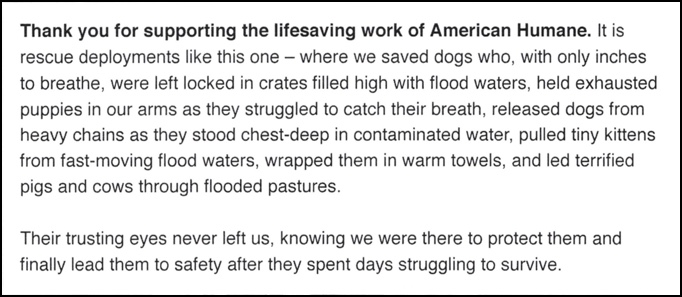
In paragraph three the writer uses the word “you” again at the beginning of the paragraph, but not again for the rest of the paragraph. And not in the next one either.
Now these paragraphs are really emotional and intense. Something I think is needed in fundraising copy. But there is a time and a place for it. And it’s not in a thank you letter.
I think this writer might have forgotten what the purpose of this letter was—to thank the donor.
Here is the last part of the letter:
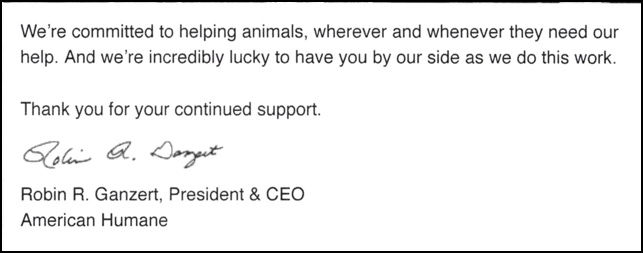
The last two sentences do use the word “you.” But by then I already felt like an afterthought.
KEEPING DONORS IS THE HARD PART
As everyone in the fundraising business knows, maintaining donors is the hardest part of the job.
And if you aren’t thanking them sincerely and passionately, and in a way that makes them feel like they are playing a major role in helping you complete your mission, you can forget a second donation.
And your organization will never meet its goals if you don’t have any recurring donors.
So get in the habit of thanking often, of thanking sincerely, and spreading the gratification far and wide.

This is such a powerful reminder for non-profits. Everyone wants to feel that their donation made a real difference. Your point about this and the examples you used are spot on. Every opportunity to engage donor emotion helps to advance the mission and keeps the much needed money flowing.
Glad you found the post valuable, Lisa. Thanks for checking it out. And come back soon.